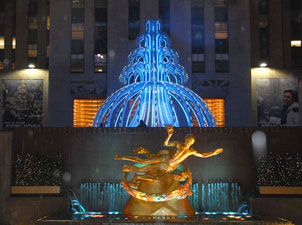
Source: Electric Fountain at Rockefeller Center NYC, Piwimedia, Wikimedia Commons

Source: Electric Fountain at Rockefeller Center NYC, Piwimedia, Wikimedia Commons
Recal what you know about resistance, current, and voltage and how they are related by Ohm's Law.
V=IR
This lesson is about the rate at which electric energy in the circuit is converted to another form of energy like heat or light. The rate of electric energy transfer is electric power, and it is measured in Watts (W). The equation for power is current multiplied by voltage.
P=IV
Power supplied by the voltage source describes the rate at which the voltage source increases the electric potential energy of charges in a circuit. Power ratings of elements within a circuit describe the rate at which the electric potential energy of the charges is used by parts of the circuit to make light, heat, or sound. Higher ratings mean brighter light bulbs, higher temperature heating elements, or louder speakers.
The law of conservation of energy requires that the sum of the power dissipated in all circuit elements be equal to the power supplied by the voltage source.
Two other equations for power are possible by substituting for either I or V in Ohm's Law.
![]() Drag Ohm's Law onto the definition for power to substitute for V.
Drag Ohm's Law onto the definition for power to substitute for V.
![]() Drag Ohm's Law onto the definition for power to substitute for I.
Drag Ohm's Law onto the definition for power to substitute for I.